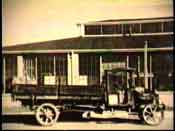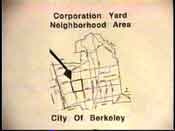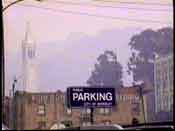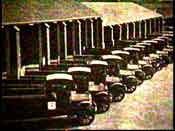SCRIPT"Traffic in Transit" a West Berkeley
area traffic plan (SUDS) presentation
The urban landscape is cluttered with automobiles. For many municipalities
like Berkeley, the impact of auto density has reached a crisis. This
is expressed in the congestion we feel. The pollution we breathe and
for some of us, the parking tickets we receive.
Hello, We are on the streets of Berkeley. The city is renown for many
things in including problems with parking and auto congestion. Our City
has experimented with a number of solutions to meet the traffic demands
of urban growth and increased automobiles.
 Slow street such as Milvia Street behind me have become a popular solution
for some of Berkeley’s traffic ills. Traditionally, the placement
of traffic lights and signs has come as a response to specific street
congestion in each district. Unfortunately, traffic control measures
like stop signs, speed bumps and traffic barriers have varied results.
These control measures can create even greater congestion.
Slow street such as Milvia Street behind me have become a popular solution
for some of Berkeley’s traffic ills. Traditionally, the placement
of traffic lights and signs has come as a response to specific street
congestion in each district. Unfortunately, traffic control measures
like stop signs, speed bumps and traffic barriers have varied results.
These control measures can create even greater congestion.
In most cities like Berkeley, traffic planning generally lags behind
area development. The lack of an effective regional planning also interferes
with Berkeley’s ability to solve its many traffic problems.
This traffic dilemma is especially evident in the south and west districts
of Berkeley which host a commuter corridor. In this section of the city,
the Berkeley flatlands, light industry, commercial and residential interests
all struggle to coexist while continuing to create a new traffic dynamics.
Lets look at one such area an West Berkeley and examine several of these
traffic issues more closely.
 West Berkeley it has been said is that place you drive through to get
to the freeway. This is a long held view because of the area’s
industrial and commercial development.
West Berkeley it has been said is that place you drive through to get
to the freeway. This is a long held view because of the area’s
industrial and commercial development.
However, this is a changing picture as residential growth continues.
This sector of District two is called the Corporation Yard Neighborhood.
The neighborhood is bound by Sacramento Street, Dwight Way, San Pablo
Avenue, and University Avenue. The Public Works vehicle maintenance
yard is the area’s largest business and it contributes to the
highest volume of vehicular traffic. Indeed, the city operations represent
a unique business.
Berkeley operates the largest fleet of vehicles within the city limits.
The city regulates, state required trip reduction required trip reduction
as a pollution control measure for both business and municipal operations.
This regulatory relationship has help slow the long awaited traffic
changes to the Corporation Yard and surrounding community.
Since the turn of the century, Berkeley’s Corporation Yard has
been located at 1326 Allston Way. This building behind me was designed
by then city architect Walter Ratcliff. Back then, Berkeley was comprised
of two areas, Oceanview and the University of California. The Corporation
Yard was constructed in the space between the two.
Residential growth did not really take off until the 1920s. It was not
long after, that the was surrounded by housing.
The first public Works vehicles were horse drawn. What once where horse
stalls and equipment sheds are now office and storage space. As transportation
technologies changes so did the community around the maintenance facility.
As the use of autos and specialized trucks by the city exploded, residential
growth contributes to a rezoning of the surrounding neighborhood. This
has resulted in the Corporation Yard becoming the largest non-conforming
land use anywhere in Berkeley.
Both Allston way and Bancroft Way gates provide direct entrance and
exit from the yard. Currently, the Allston Way gate provides twenty-four
hour service to the yard. The Bancroft Way gates are only used from
6:00 AM to 4:30 PM, Monday through Friday.
 In addition to maintaining the city’s vehicles, the Corporation
Yard contains the central fueling station for nearly all of Berkeley’s
trucks, specialized equipment, and automobiles. Most of these are stationed
at the Yard where they are also serviced. Refuse trucks from the Transfer
Station occasionally fuel at the Yard too.
In addition to maintaining the city’s vehicles, the Corporation
Yard contains the central fueling station for nearly all of Berkeley’s
trucks, specialized equipment, and automobiles. Most of these are stationed
at the Yard where they are also serviced. Refuse trucks from the Transfer
Station occasionally fuel at the Yard too.
The last time any changes were purposed for the facility’s traffic
and circulation plan was 1987. More to come...
Quote
on seeing video..."They always say a picture's worth a thousand
words, and undoubtedly the pictures made an impression
on us," said Councilwoman Diane Woolley-Bauer. (1995)
TO: Transportation Commission
FROM: C.E. DeLeuw Jr. Traffic Engineer, February 22, 1995
SUBJECT: CORPORATION YARD IMPROVEMENTS -
The purpose of this memorandum is to present a status report on various items regarding improvements to the Corporation Yard in response to a proposal submitted to the City clerk on December 7, 1994 and subsequently presented to the Transportation Commission by L A Wood. The Commission also viewed a video tape (Traffic In Transit, West Berkeley SUDS traffic plan) which visually showed examples of some of the neighbors concerns.
Traffic Plan
Traffic circulation within the Corporation Yard is being reviewed by staff. Location of access gates and direction of travel through those gates are issues being evaluated. Internal congestion points and parking arrangements are also being considered. Decisions regarding these matters will be concluded in March 1995. The gate location recommendations will serve as input into the ongoing design of the WALL to be installed along the Bancroft frontage of the Corporation Yard. Corporation Yard management has also curtailed traffic on Acton Street by large vehicles (greater than 3/4 tons) in the vicinity of the Corporation Yard.
Trip Reduction
The City is required by the Bay Area Air Quality Management District to evaluate work trip travel modes for all sites which employ 100 or more people. The Corporation Yard is one of these sites. As part of this effort the City conducted a travel survey of employee work trips during a regular work week in November, 1994. Some 130 of 178 Corporation Yard employees responded. The site just missed meeting the 1994 Air District trip reduction goal. Therefore, the City is required to prepare a trip reduction plan for the Corporation Yard.
Air District work trip travel goals become progressively more strict between 1994 and 1999. For instance, the 1994 goal was 0.87 compared to 0.83 in 1995 and 0.74 in 1999. The ratio represents number of cars driven to work per 100 employees.
The travel survey data are being forwarded to the Air District. The Air District will officially notify the City where the survey data does not meet the 1994 travel goals. The City will then be given 120 days to prepare a trip reduction plan for those sites which did not meet these goals. The plan is then submitted to the Air District for review and comment. Once a final trip reduction plan is approved implementation will follow.
Some examples of type of strategies that the Air District suggests might be used in a trip reduction plan to reduce the number of single occupant vehicles include the following:
- Transit Ticket sales
- Van Pools Assistance
- Preferential parking for car and van pools
- Ride Matching
- Guaranteed ride home program
- Parking charges
- Compressed work week
- Vehicle buy back
- Marketing
- Shuttles
During the development a trip reduction plan for the Corp Yard, the City will determine which strategies will and will not be effective and feasible.
Alternate Fueling Schemes
The City has a variety of fueling strategies and is actively pursuing the potentials. Currently, 14 of 30 parking enforcement scooters are electric powered. Credit card fueling at regular gas stations is used but for emergencies only since the difference in fuel cost is substantially higher than available through the City.
The City has been evaluating potential sites to locate a compressed natural gas fueling facility. It is estimated that such a site might be available in the 1996/97 fiscal year. This facility would not be located in the existing Corporation Yard. Creation of a compressed natural gas fueling facility would facilitate the conversion of more vehicles to that type of fuel.
There are existing policies regarding where vehicles are to be fueled such as at the Transfer Station or the CorporationYard as well as policies regarding fueling at the end of the work day. These policies will be restated so that all employees are made aware of the goals. Practice will be monitored to assure reasonable compliance.

 Slow street such as Milvia Street behind me have become a popular solution
for some of Berkeley’s traffic ills. Traditionally, the placement
of traffic lights and signs has come as a response to specific street
congestion in each district. Unfortunately, traffic control measures
like stop signs, speed bumps and traffic barriers have varied results.
These control measures can create even greater congestion.
Slow street such as Milvia Street behind me have become a popular solution
for some of Berkeley’s traffic ills. Traditionally, the placement
of traffic lights and signs has come as a response to specific street
congestion in each district. Unfortunately, traffic control measures
like stop signs, speed bumps and traffic barriers have varied results.
These control measures can create even greater congestion. West Berkeley it has been said is that place you drive through to get
to the freeway. This is a long held view because of the area’s
industrial and commercial development.
West Berkeley it has been said is that place you drive through to get
to the freeway. This is a long held view because of the area’s
industrial and commercial development.  In addition to maintaining the city’s vehicles, the Corporation
Yard contains the central fueling station for nearly all of Berkeley’s
trucks, specialized equipment, and automobiles. Most of these are stationed
at the Yard where they are also serviced. Refuse trucks from the Transfer
Station occasionally fuel at the Yard too.
In addition to maintaining the city’s vehicles, the Corporation
Yard contains the central fueling station for nearly all of Berkeley’s
trucks, specialized equipment, and automobiles. Most of these are stationed
at the Yard where they are also serviced. Refuse trucks from the Transfer
Station occasionally fuel at the Yard too.